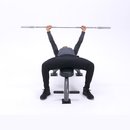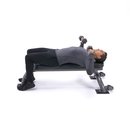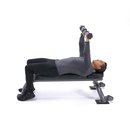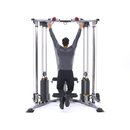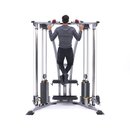'Tis the time of year to pack up the holiday ornaments, store the items you intend to re-gift for next year, and shop for new pants because of the weight you gained over the holidays.
Well, it is for some people. We have a better idea for you. Get that now-XXL butt of yours back to the gym and restart your membership.
Finding a New-Year's-resolution-inspired training program is easy: for one, you can just follow the workout below. Nothing sinks motivation faster than a lack of progress, and this one is geared toward propelling you all the way to intermediate status in just two months. No spinning your wheels on equipment for months and making no appreciable gains; the aim here is to build upon earlier successes so that momentum and motivation build from one workout to the next.
This program has two parts. The two-day beginner's split (you cover all the major body parts over two days, repeating it twice per week) isn't geared for rank beginners; for that, check out The Ultimate Beginner's Full-Body Workout. We assume some familiarity with basic exercises. Maybe you're coming back from an extended layoff or injury. Maybe you've been following a beginning-level routine for a while and are ready to take the next step up. Either way, you're in the right place.
Here are a few of the highlights and features of this beginner-to-intermediate program:
1. Start by splitting your workouts
For the first four weeks you follow a two-day split, broken into an upper- and lower-body workout. You'll work all the major muscle groups to build a stronger and balanced physique, which also prevents muscular imbalances that can arise when you favor some muscle groups over others. Such imbalances could lead to injury—which will hold back your progress big-time.

Working all the major muscle groups helps to build a stronger and balanced physique.
2. Practice form, form, form
The first month is geared toward understanding the basic movement patterns, learning good technique, feeling muscles work, and determining a challenging weight for each movement. After warm-up sets, which are never taken to muscle failure, you'll do 3-4 working sets for a target rep that's listed in the workout.
Understanding the relationship between weight and reps is critical; while it seems obvious that the more weight you do the fewer times you can lift it, what you want to do this first month is find the exact weight in which you can do just 12 reps, and no more. If you choose a weight that's too light and you can do more than 12 reps, add weight for your next set.
You want to ensure the last rep or two is very tough, verging on muscle failure. If you're using sloppy form to achieve that last rep or two, that doesn't count; you're going too heavy.
3. Add weight slowly
Most gains in strength that come during the first month result from neurological adaptations that take place, rather than from actual increases in the size and strength of muscle fibers. That's one reason you aren't going with heavier weights for lower reps the first month, or even to muscle failure. But once you can do more than 12 reps with a given weight, add about 5 percent to the weight. Keep your reps in the 10-12 range during the first phase. Resist the urge to go heavy.

Keep your reps in the 10-12 range during the first phase. Resist the urge to go heavy.
4. Adjust volume, intensity, and frequency
The second month you'll follow a three-day split. Volume and intensity are increased for each body part, so you'll train each muscle group slightly less often—from twice a week to once every 4-5 days. By volume, we're talking about the number of exercises, sets, and reps. This is done by adding another exercise for each muscle group, which allows you to train the target body part from a different angle to stimulate better overall growth.
By intensity, we're referring to the amount of weight you're using. Instead of choosing a weight in which you can do 12 reps, you'll be selecting a slightly heavier resistance that you can do for 8-10 reps, and sometimes as low as 6. This relatively heavier weight, in addition to the increase in training volume, is a trigger for muscle growth, or hypertrophy, when combined with good nutrition and rest.
5. Use more muscle with multi-joint movements
For most body parts, the workouts rely on multi-joint exercises for optimal gains in size and strength. Exercises are classified either as multi-joint or single-joint moves. With multi-joint exercises, two or more sets of joints are working to accomplish the lift. With a single-joint move, only one set of joints is working.

With multijoint exercises, two or more sets of joints are working to accomplish the lift. With a single-joint move, only one set of joints is working
During a bench press, for example, action is taking place at both the elbow and shoulder joints, while in a barbell curl the movement is restricted to the elbow joint. Because more muscle groups are engaged when doing multijoint moves, you can use far heavier weights, which are therefore better choices for achieving muscle and strength gains.
6. Learn how to train to failure
While in Phase One we suggest you choose a weight that approaches muscle failure, during the second phase, you actually want to test your physical limits. By that we mean that if you can do another rep with good form on a given set, do it. Keep going until you can't do any more reps on your own with good form.
Keep in mind, however, that if you can do more reps than the target listed for a given exercise, you need to increase the weight. Conversely, if you can't reach the target rep, it's probably too heavy and you may need to reduce the weight.
As you fine-tune the amount of weight that you use, be mindful that achieving muscle failure is your goal, excluding warm-up sets. And remember, never sacrifice form to lift a weight that's too heavy.
7. Hit failure more often by following a reverse pyramid
The rep targets follow a reverse-pyramid scheme during the second phase. That is, after you do your warm-up sets for a given move (do as many as you need but never take warm-ups to muscle failure), choose a weight in which you can just reach the rep target. That will be the heaviest weight you'll do for a given exercise, because each succeeding set is for the same rep target or a higher target (with a higher target you use a slightly lighter weight).
Following a reverse-pyramid scheme—the set sequence progresses to lighter weights for more reps—allows you to train to failure on each set, unlike a normal pyramid, when lighter-weight sets are not taken to muscle failure. Again, it's important to note the link between taking multiple sets to failure and anabolism, the state that promotes muscle growth.
8. Add weight as you get stronger
Increase the overload as you become stronger. Your body responds to the training stimulus by growing bigger and stronger, but if you do the same weight for the same reps each workout, it doesn't need to respond any further. So don't fall into the rut of repeating the same workout week in, week out.
Challenge yourself to do more reps with a given weight or increase the weight from one workout to the next—that's the progressive stimulus you need to keep making positive improvements. That's where using a training log to write down your exercises, sets, and reps can help. Once you can do more than the target rep listed, add weight.
9. Learn how to execute the perfect rep
For both safety and performance, it's essential that you master the elements of lifting correctly. Inhale and hold your breath as you lift the weight in a strong and forceful manner, exhaling only over the top portion of the movement. Then lower the weight under control as you breathe in.
Reverse direction smoothly at the bottom position, never bouncing the weight in an effort to aid in the lift. Don't use momentum or body English to assist you in lifting a weight. And never ever lock out a joint.

Inhale and hold your breath as you lift the weight in a strong and forceful manner, exhaling only over the top portion of the movement. Then lower the weight under control as you breathe in.
Practice each exercise over and over, and soon enough you'll do the movements naturally without having to think about all the details of good form. But if you're repeating sloppy form from the start, you might not know it until you incur an injury.
10. Keep rest intervals short between sets
Rest 60-120-seconds between sets. In bodybuilding exercises, you want to take a short rest between sets to catch your breath and allow the blood to clear away the metabolic byproducts of intense training, so that you're sufficiently recovered for your next set.
There's no one-size-fits-all amount of time, as larger body parts (legs, back) and more intense sets (weights closer to your one-rep max) usually take longer to recover. Most of you can start your next set after catching your breath.
11. Don't repeat workouts too soon
As we stated earlier, the work you do in the gym is the stimulus for muscle building; the actual repair and growth occurs outside the gym and requires good nutrition and rest. For this reason, don't repeat a workout too quickly. The process of protein synthesis requires nutrients, time, and your naturally occurring hormones, which are secreted primarily during sleep. Shortchange any of these factors and your growth will suffer.
In terms of training frequency, don't hit a given muscle group more frequently than once every 48 hours. As you become more advanced and add volume, you'll want to increase that rest period, which we do in the second phase. Hence the scheduled off-days from the gym.
The process of protein synthesis requires nutrients, time, and your naturally occurring hormones, which are secreted primarily during sleep.
Because of this no-repeat rule, how you set up your split becomes important for recovery. You'll notice that on the three-day split, the push muscles (chest, shoulders, and triceps) are all worked one day, because many of those muscles assist in exercises for other body parts. For example, when bench pressing, you don't work just the pecs but also the delts and triceps.
If you were to arrange your split in another manner—say, doing chest on day one, shoulders on day two, and triceps on day three—you would lack sufficient recovery time.
12. Keep changing to keep growing
Prepare to take your training to the next level in eight weeks! As a beginner, you'll make noticeable jumps in strength the first month. You'll also find that gains usually start to stall when following any given program for too long. That's why this program introduces elements to keep you progressing: a change in your training split, an increase in the volume of work for each body part, and an increase in the intensity, which means using heavier weights for lower-rep targets.
It's important to explore what making changes in different training variables such as these affect size and strength gains. Learning how to manipulate these variables helps keep your training fresh and offers new challenges to overload the target muscles.
Pursue the 12 keys in this article and you won't be a beginner for long.

Prepare to take your training to the next level in eight weeks.
The 8-Week Fast Track To Intermediate Workout
Weeks 1-4
- Do the upper- and lower-body workout twice per week, inserting 1-2 rest days once you complete both workouts. You should work out four days total per week.
- Do two exercises for each of the major muscle groups.
- The first four weeks you'll be practicing your form, so the weight should be fairly light. Choose a weight that you can do for 12 reps for the listed number of sets.
- Warm-up sets are not included; do as many as you need, but never take warm-ups to muscle failure.
- As you get stronger and can do more than the target number of reps, increase the weight slightly.
- If a given free-weight exercise is too difficult, find its machine counterpart and practice on it to rehearse the form before going back to free weights.

BodyFit
$6.99/month- 2,500+ expert-created single workouts
- 3,500+ how-to exercise videos
- Detailed workout instruction
- Step-by-step workout tips
- Training at gym or at home
- Access to Workout Plans
- Access to Bodyfit App
- Store Discounts
Already have a Bodybuilding.com account with BodyFit? Sign In

What comes with BodyFit?

- Instructional Videos
Don't risk doing a workout improperly! Avoid injury and keep your form in check with in-depth instructional videos.

- How-to Images
View our enormous library of workout photos and see exactly how each exercise should be done before you give it a shot.

- Step-by-Step Instructions
Quickly read through our step-by-step directions to ensure you're doing each workout correctly the first time, every time.

BodyFit
$6.99/month- 2,500+ expert-created single workouts
- 3,500+ how-to exercise videos
- Detailed workout instruction
- Step-by-step workout tips
- Training at gym or at home
- Access to Workout Plans
- Access to Bodyfit App
- Store Discounts
Already have a Bodybuilding.com account with BodyFit? Sign In

What comes with BodyFit?

- Instructional Videos
Don't risk doing a workout improperly! Avoid injury and keep your form in check with in-depth instructional videos.

- How-to Images
View our enormous library of workout photos and see exactly how each exercise should be done before you give it a shot.

- Step-by-Step Instructions
Quickly read through our step-by-step directions to ensure you're doing each workout correctly the first time, every time.
Weeks 5-8
- Do the three workouts in order followed by a rest day, so the cycle should repeat every five days. You can also take Sundays or another day off per week as well, so that you're working out 4-5 days per week.
- Increase the number of exercises you do for each major body part to three. The additional exercise is from a different angle, so the target muscle is worked differently.
- Warm-up sets are not included; do as many as you need, but never take warm-ups to muscle failure.
- On your working sets, choose a weight so that you achieve muscle failure by the target rep. Adjust the weight up or down as necessary. Some sets call for a higher rep target on the second or third set; this is part of a reverse pyramid and means you should reduce the weight by 5-10 percent and do a higher number of reps. Because your fatigue levels increase from one set to the next, it allows for multiple sets to failure with the same exercise.
- As you get stronger and can do more than the target number of reps, increase the weight by 5 percent for upper-body exercises and 10 percent for lower-body exercises.
- Strive to learn new movements. Most free-weight exercises have machine counterparts, but the barbell and dumbbell version is always harder because it requires you to balance the weight and keep your core tight.

BodyFit
$6.99/month- 2,500+ expert-created single workouts
- 3,500+ how-to exercise videos
- Detailed workout instruction
- Step-by-step workout tips
- Training at gym or at home
- Access to Workout Plans
- Access to Bodyfit App
- Store Discounts
Already have a Bodybuilding.com account with BodyFit? Sign In

What comes with BodyFit?

- Instructional Videos
Don't risk doing a workout improperly! Avoid injury and keep your form in check with in-depth instructional videos.

- How-to Images
View our enormous library of workout photos and see exactly how each exercise should be done before you give it a shot.

- Step-by-Step Instructions
Quickly read through our step-by-step directions to ensure you're doing each workout correctly the first time, every time.

BodyFit
$6.99/month- 2,500+ expert-created single workouts
- 3,500+ how-to exercise videos
- Detailed workout instruction
- Step-by-step workout tips
- Training at gym or at home
- Access to Workout Plans
- Access to Bodyfit App
- Store Discounts
Already have a Bodybuilding.com account with BodyFit? Sign In

What comes with BodyFit?

- Instructional Videos
Don't risk doing a workout improperly! Avoid injury and keep your form in check with in-depth instructional videos.

- How-to Images
View our enormous library of workout photos and see exactly how each exercise should be done before you give it a shot.

- Step-by-Step Instructions
Quickly read through our step-by-step directions to ensure you're doing each workout correctly the first time, every time.

BodyFit
$6.99/month- 2,500+ expert-created single workouts
- 3,500+ how-to exercise videos
- Detailed workout instruction
- Step-by-step workout tips
- Training at gym or at home
- Access to Workout Plans
- Access to Bodyfit App
- Store Discounts
Already have a Bodybuilding.com account with BodyFit? Sign In

What comes with BodyFit?

- Instructional Videos
Don't risk doing a workout improperly! Avoid injury and keep your form in check with in-depth instructional videos.

- How-to Images
View our enormous library of workout photos and see exactly how each exercise should be done before you give it a shot.

- Step-by-Step Instructions
Quickly read through our step-by-step directions to ensure you're doing each workout correctly the first time, every time.




